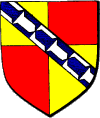Vair
Vair
Vair, (fr. vairé), generally written vairy when definite tinctures are named: a party-coloured fur, properly argent and azure, which tinctures are always implied when no others are mentioned; but, as will be seen, it occurs even in the early rolls of different tinctures. For instances, at the siege of Carlaverock 'the valiant Robert DE LA WARDE, who wards his banner so well,' bore it 'vairy of white and of black.'
Apres li vi-je tout premier Ke ben sa baniere rewarde
Le vaillant Robert de la Warde Vairie est de blanc e de noir.
The origin of the name is not clear, but the most probable conjecture is that it is derived from a little animal whose fur was much in request, the ver, or vair, differently spelt, and which appears in Latin as varus. The word seems to have been used independently of heraldry for fur, and the following curious error may be noted in passing. The familiar fairy tale of Cinderella was brought to us from the French, and the slippers made of this costly fur, written probably verré for vairé, were erroneously translated 'glass slippers,' which of course was an impossible material, but has been repeated in all nursery tale-books.
Menu-vair is used by French heralds when there are more than four rows, the term being considered as implying a diminutive vair. It is borne much by Flemish families, possibly in connection with trade associations. The menu-vair, or as we call it, minever, was a term used in the Middle Ages for the fur lining of robes of state.
Beffroi, or gros vair, is used when there are less than four rows. The name is evidently derived from the bell-like shape of the vair, the word beffroi being anciently used in the sense of the alarm-bell of a town. It is said that when French heralds use the term vair only, that four rows exactly are intended.
De menu-vair de cinq tires, au chevron de gueules--STESSIN, Flanders.
Plein de menu-vair--BANVILLE DE TRUTEMNE, Normandie.
De beffroi, d'or et d'azur--D'AUBETERRE, Champagne.


In modern heraldry the figures of a shield-shape are generally drawn as in the second figure(arms of BEAUCHAMP), but in the older designs it was similar to that shewn in the arms of the Earl FERRERS, Earl of Derby, 1254-65, the sketch being taken from almost contemporary stained glass in Dorchester Church, Oxon; and sometimes the division lines are drawn after the same manner as nebuly.
Le Conte de FERRERS, verree de or et de goules--Roll, temp. HEN. III.
Hugh de FERRERS, vairre de argent et d'azur--Ibid.
Robert de BEAUCHAMP, de vairrie--Ibid.
Piers de MAULEE, de veirre a la manche de goules--Ibid.
Sire Hugh de MEYNI, verre de argent e de sable, e un label de goules--Roll, temp. ED. II.
Monsire John de BEAUCHAMP de Somersetshire, port de verre--Roll, temp. ED. III.
Monsire de NOWERS, port verre d'argent et de gules--Ibid.
Monsire La WARD, port verre d'argent et sable--Roll, temp. ED. III.
Vairy argent and azure--BEAUCHAMP.
Vairy argent and gules--GRESLEY, Norfolk.
Vairy argent and sable--MAYNELL.
Vairé, ermine and gules--GRESLEY, Derbyshire.


Besides being applied to the field, it is often found applied to ordinaries and some few charges; and in some cases even to animals.
Or, [another gules], a saltire vair--WILLINGTON of Umberleigh, co. Devon, and Hurley, co. Warwick.
Sire Johan de HOORNE, de goules a une frette de veer--Roll, temp. ED. II.
Quarterly, or and gules, a bend vair--SACKVILLE.
Paly of six or and gules; a chief vair--Francis ATTERBURY, Bp. of Rochester, 1713-23.
Argent, a bend sable and chief vair--Michael de NORTHBURG, Bp. of London, 1461-66.
Barry of six, vaire gules, and ermine, and azure--Gules de BRAOSE, Bp. of Hereford, 1200-16.
Sire Adam de EVERINGHAM, de goules, a un lion rampaund de veer--Roll, temp. ED. II.

But different forms of vair occur, apart from the tincture. The term counter vair(fr. vairé contre vairé) has been adopted to signify that the shield-like forms instead of alternating singly alternate in pairs, so that each 'piece' represents a pair of shields united at their tops, as shewn in the margin; but this form does not seem to have been adopted in any arms which can be said to be distinctly English, though some of the families may possibly be represented in England. The form has probably arisen only from incorrect drawing.
Counter-vary or and gules--BROTIER.
De contre-vair; au franc canton d'hermine--SALPERWICK, Artois.
Vairé contrevairé d'or et d'azur--TRAINEL, Ile de France.

Again, Vair en pointe is a term applied by Nisbet to an arrangement by which the azure shield, pointing downwards, has beneath it an argent shield, also pointing downwards, and vice versa, by which the effect shewn in the margin in produced. There are one or two coats of arms so blazoned, but it is not at all clear that this is the design meant. Also one coat appears with four tinctures.
Vairy en point argent and azure--DURANT.
Vairy en point gules and argent--MONKHOUSE.
Vairy argent, azure, gules, and or en point--Roger HOLTHOUSE.
Heraldic writers also speak of varry as meaning one of the pieces of which the vair is composed; they also used the terms vairy cuppy and vairy tassy for potent counter potent, perhaps from the drawings in some instances resembling cups, and that in the possible meaning of tassa. It may be said that all these variations of the ancient vair arise from mere accident(generally bad drawing), supplemented by over refinement on the part of the heraldic writers who have described them.
Please Help!
DrawShield is a Free service supported by its users.

If you can, please help cover the cost of the server, or just buy the team a coffee to say thanks!
 Buy me a coffee
Buy me a coffee


